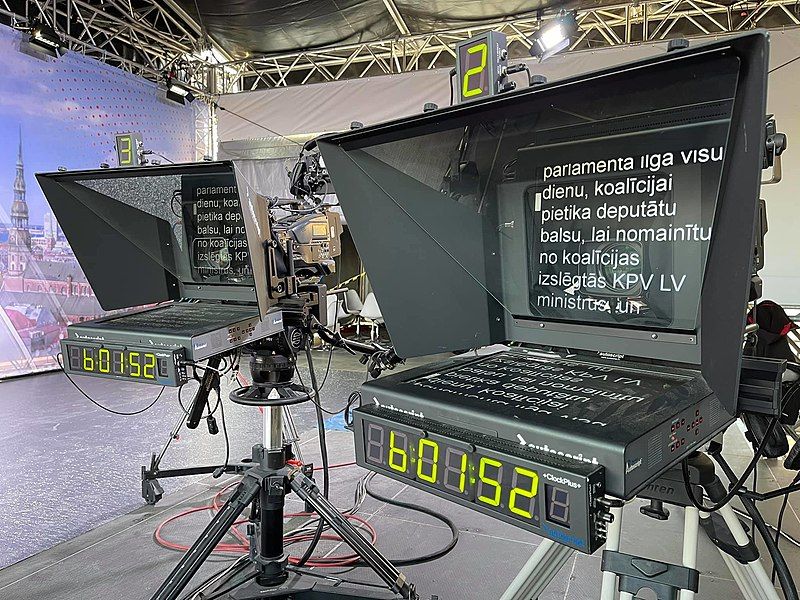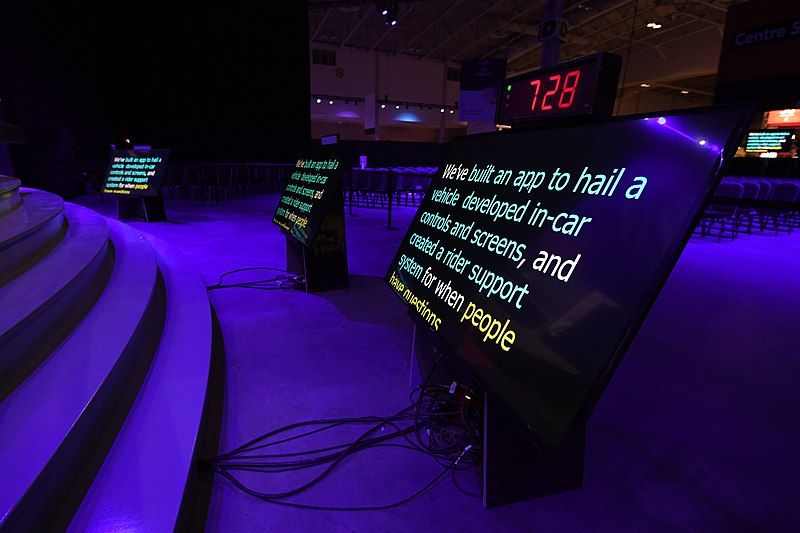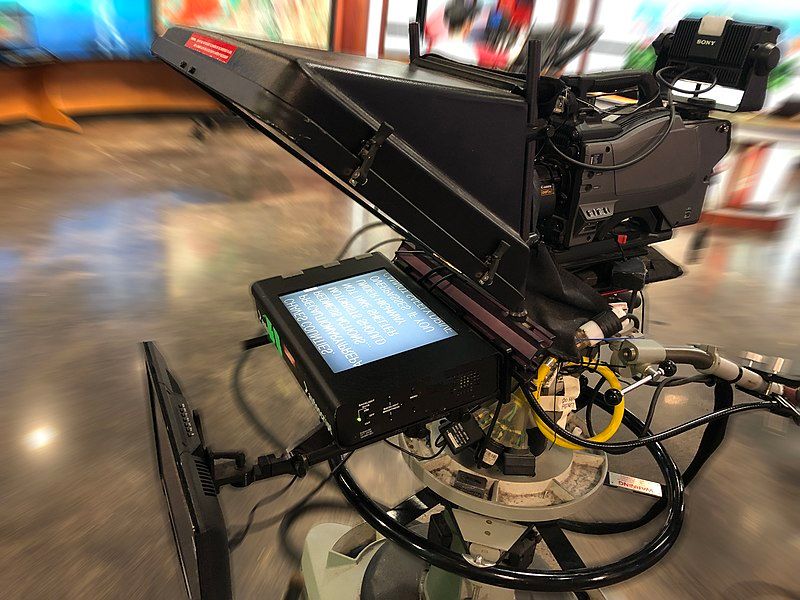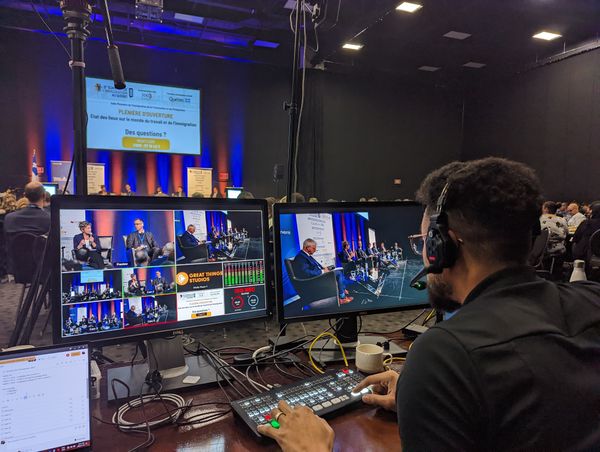How to Use a Teleprompter: Your Ultimate Shooting Guide
You’re shoot is coming in a few days, and you’ve decided to work with a teleprompter?
It’s always a good idea to practice a bit before the official shooting day!
News anchors use teleprompters all the time and they look so natural that you don’t notice it.
You can also look that smooth with a bit of practice!
Using teleprompters can be an effective way for presenters to deliver speeches or presentations without having to memorize their script.
A teleprompter is a device that displays text on a monitor, allowing the presenter to read their script while looking directly at the camera or audience. The glass piece is called a beam splitter (no.4 on the illustration below). The auto-scroll feature of teleprompters is especially useful for videos.

In this article, we will discuss how to use a teleprompter effectively, why you should consider using one, and what it is used for.
Moreover, using a teleprompter can help reduce anxiety during presentations, as presenters will feel more confident knowing that they have their script in front of them.
Step One: Choosing Your Teleprompter
There are several types of teleprompters available in the market today. You can choose from traditional stand-alone teleprompters or more modern options such as iPad, iPhone, and Mac by downloading teleprompter apps.

These apps are available for both iOS and android platforms and allow users to control the speed and direction of the text on their device screens.
If you’re working with a professional crew like ours at Great Things Studios, we’ll usually bring our own teleprompter setup. We like to use promoters that are between 13 and 16’ inches of size, which is big enough for 95% of our corporate shoots. It’s a combination of a teleprompter app software and physical hardware.
If you feel like it, you can even build your own teleprompter, bit overkill, but still, a possibility if you’re handy!
Step Two: Setting Up Your Teleprompter
Once you have chosen your preferred type of teleprompter, it's time to set it up. First-time users might find it helpful to practice with shorter scripts before moving on to longer ones.
When setting up your teleprompter app, make sure that the font size and color are comfortable for you to read. Adjusting these settings beforehand will save time during your presentation.
It's usually white text on black background. But you can choose whichever you prefer.
Step Three: Using Your Teleprompter Effectively
Using a teleprompter effectively requires some practice. It's important not only to read from the screen but also maintain eye contact with your audience.
To do this effectively, try placing your device at eye level so that you can look straight ahead while reading your script. Practice speaking naturally and at a comfortable pace. Remember to pause when necessary and emphasize key points.
The further away you are from the teleprompter, your eye movement is less visible.

Mastering the Art of Using a Teleprompter
TRT: Understanding the Total Run Time of Your Video
To master the art of using a teleprompter, it's important to understand the total run time (TRT) of your video. The TRT refers to the amount of time your video will run from start to finish. Knowing this information is crucial for ensuring that your script fits within the allotted time and that you can deliver an effective speech.
Calculating your TRT may seem like a daunting task, but it's actually quite simple. Start by adding up the length of each segment of your video, including any intros, outros, and transitions.
Keep in mind that speaking at a natural pace may result in a longer TRT than anticipated. If your TRT is longer than desired, consider editing down your script or adjusting the speed at which you speak.
Knowing your TRT can also help you plan for any necessary breaks or pauses during filming. For example, if you have a long script that requires multiple takes, you may need to take breaks to rest your voice and maintain energy throughout filming.
Keep in mind that knowing this is only necessary if you’re shooting a video that has very strict video length and guideline. If the length of the final video is not that important, you can simply go with the flow and read as naturally as possible.
Using a Teleprompter: Tips and Tricks
Practice reading from the teleprompter before filming begins. This will help you get comfortable with its speed and adjust accordingly if needed.
Thirdly, keep in mind that using a teleprompter doesn't mean you should sound robotic or rehearsed. Speak naturally and use hand gestures to engage with your audience.

Outlining Your Script Instead of Word-for-Word Reading
Script reading can be a daunting task, especially if you are not used to it. It can be distracting to read lines word-for-word and may give the impression that you are not entirely present in the moment.
Luckily, there is an alternative way to approach script reading that makes for a more natural look on camera: outlining your script.
The Benefits of Outlining
When you outline your script, you have only bullet points instead of a full text. This allows for more flexibility and gives room for improvisation while still staying within the confines of the content.
It’s a bit like presenting with a PowerPoint speech. You rarely put a full script within this kind of presentation.
You can practice beforehand and get comfortable with the ideas presented in your script without getting bogged down by memorizing every single word.
Another benefit of outlining is that it helps keep focus on what’s important. When reading from a full text, it’s easy to get lost in small details or get sidetracked by tangents.
With an outline, you can frame your thoughts and stay on track with your message.
How to Outline Your Script
When creating an outline, there are several things to consider: style, font size, parser options, and where to place it during filming. The style should be clear and easy-to-read so that you can glance at it quickly without losing focus on the camera or audience.
Font size should also be considered; too small may make it difficult to read while too large may take up too much space on the teleprompter screen. Consider using bold or italicized fonts for emphasis when necessary.
Another consideration about font size is the ability to predict what’s coming next. So make sure it’s not to big so that you can read ahead.
There are many different parser options available depending on how detailed you want your outline to be. Some people prefer bullet points while others like numbered lists or even flowcharts. Choose what works best for you and what will help keep you organized during filming.
Some teleprompter system, like the ones we use at Great Things Studios, allows even for images and PowerPoint. This way, if you already have content in this format, you won’t have to go through the hassle of converting them into regular text.
Finally, decide where to place your outline during filming. Obviously, with a real prompter, your text will be right in front on the lens, projected on the angled beam splitter glass.
Taking a Deep Breath
When it’s time to film, take a deep breath and relax. Remember that outlining your script is meant to make the process easier, not more stressful.
Glance at your outline when necessary but try not to rely on it too heavily; the goal is to come across as natural and authentic as possible.
Tips and Tricks for Looking Natural While Using a Teleprompter
Using a teleprompter may seem daunting at first, but with a few simple tips, you can look and sound like a pro. One of the most important things to remember when using a teleprompter is to speak naturally.
Imagine that you're having a conversation with a friend, and try to replicate that same relaxed tone of voice. This will make your delivery more engaging and authentic. Another helpful tip is to practice reading the script beforehand so that you're familiar with the words and phrasing.
This will help you avoid stumbling over words or sounding stilted. And finally, be sure to maintain eye contact with your audience, even if you're reading from the teleprompter. This will help you connect with your viewers and keep them engaged throughout your presentation. With these tips in mind, you'll be able to use a teleprompter like a pro in no time!
Adjust the Angle of the Teleprompter beam splitter to Match Your Eye Level
One of the most important tips for using a teleprompter is to ensure that the angle of the glass matches your eye level. This will help you maintain direct eye contact with your audience and avoid looking down or up, which can be distracting. To achieve this, we’ll adjust the system before we start the shoot.
Practice Your Speech at The Speed You Plan to Deliver It to Ensure Smooth Scrolling of The Text
Practicing your speech beforehand is crucial in ensuring smooth scrolling of text while using a teleprompter. By practicing at your planned speed, you can get used to how fast or slow you need to speak in order for the text on screen to scroll smoothly without interruption. This will also help you avoid stumbling over words or losing your place while speaking.
Hold The Hand Controller At A Comfortable Distance, About An Inch From Your Body
Some system come with a Bluetooth controller. You can even use your clicker. We used the Logitech Spotlight often with our teleprompter apps.
The hand controller or clicker is an essential tool when using a teleprompter, as it allows you to control the speed and direction of scrolling text.
It's important to hold it at a comfortable distance from your body - about an inch away - so that you can easily access it without having to reach too far forward or strain yourself.
Maintain Eye Contact With Your Audience by Looking Directly At The Teleprompter Glass Instead Of Reading The Text
When using a teleprompter, it's important to maintain direct eye contact with your audience. This can be achieved by looking directly at the teleprompter glass instead of reading the text. By doing this, you can give the impression that you're speaking naturally and confidently without relying too much on the script.
Test Equipment Before Broadcast
Of course, while practising, make sure all your equipment is fully operational. Tablet battery, clicker battery, no viruses or bugs in your system. This way, you won’t be disrupted during your reading.
Establish Clear Communication with the Teleprompter Operator
It is essential to establish clear communication with the teleprompter operator before the shoot. This will help to avoid any misunderstandings or delays during the production process.
Always make sure all your scripts have a consistent format. Adjusting format and text on set can be time-consuming.
Before the shoot, provide the operator with the script ahead of time! Extremely important for a smooth shoot.
Make sure they are familiar with any specific pronunciations or technical terms that may be challenging to read. Work together to establish a comfortable reading pace and make adjustments as necessary throughout the shoot.
It's also crucial to trust the operator to make real-time adjustments to the teleprompter speed and text size. They can accommodate any changes in delivery or timing that may occur during filming. By establishing clear communication beforehand, you can ensure that everyone involved in producing your video is on board with your vision.
Make Real-Time Adjustments
During filming, it's common for changes in delivery or timing to occur. To accommodate these changes, trust your teleprompter operator to make real-time adjustments as needed.
For example, if you're speaking too quickly or too slowly, they can adjust the teleprompter speed accordingly. If you need more space between lines of text on-screen for easier reading, they can adjust font sizes without disrupting flow or continuity of message delivery.
By working closely with your teleprompter operator, you can ensure that your video is edited smoothly and efficiently. This will save you time and money in post-production, and help you to deliver an engaging, high-quality video that resonates with your audience.
Some of our preferred free apps to practice your teleprompter skills
- Elegant teleprompter and the iOS version.
The future of Telepompters
Some apps can now automatically move the text forward as you speak (for word for word scripts). They’re not 100% accurate yet, but the technology is moving fast.
But with the advancement of AI technology we think that a few things will happen.
Automatic speech correction with lip matching!
During video post-production, AI will be able to fix words and hesitation and automatically adjust mouth movement. Yes, Google did a presentation there last Goole IO event in May. Even though this technology is used for translation, the same mechanism can be applied to speech correction.
But it’ll be some time before rendering the teleprompter useless.
Crazy yes. What an interesting time we live in!




